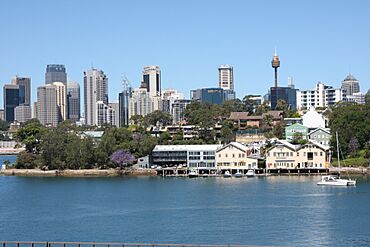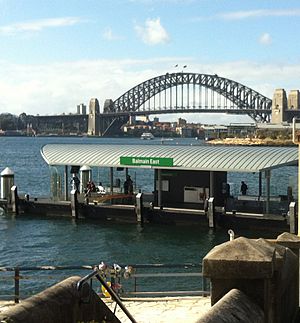Balmain East facts for kids
Quick facts for kids Balmain EastSydney, New South Wales |
|||||||||||||||
|---|---|---|---|---|---|---|---|---|---|---|---|---|---|---|---|

Simons Point, Balmain East
|
|||||||||||||||
| Established | 1995 | ||||||||||||||
| Postcode(s) | 2041 | ||||||||||||||
| Elevation | 32 m (105 ft) | ||||||||||||||
| Area | 0.3 km2 (0.1 sq mi) | ||||||||||||||
| Location | 5 km (3 mi) west of Sydney CBD | ||||||||||||||
| LGA(s) | Inner West Council | ||||||||||||||
| State electorate(s) | Balmain | ||||||||||||||
| Federal Division(s) | Grayndler | ||||||||||||||
|
|||||||||||||||
Balmain East is a cool suburb in Sydney, Australia. It's part of the Inner West area in New South Wales. You can find Balmain East about three kilometres west of Sydney's main city centre. It's managed by the Inner West Council.
This suburb sits on the eastern tip of the Balmain peninsula. It's right on Sydney Harbour! Balmain East shares a border with its neighbour, Balmain, to the west. The postcode for Balmain East is 2041. This postcode also includes Balmain and Birchgrove.
Contents
History and Culture in Balmain East
How Balmain East Got Its Name
The land that is now Balmain East was once a huge area. It was given to a colonial surgeon named Dr. William Balmain in 1800. This gift of land, about 550 acres, came from Governor John Hunter.
People first started settling here in 1836. By 1861, the area was split. The eastern parts of Balmain were quite busy. The western parts were less populated.
The "East End" of Balmain
For many years, locals called the small peninsula "East Balmain" or "The East End." This area was generally east of Hart Street and the Balmain Bowling Club. There used to be a natural swamp here. It was filled in during the early 1800s. Even though people called it East Balmain, it was still seen as part of the larger Balmain suburb.
Balmain Markets: A Local Treasure
The Balmain markets are a great place to visit. They show off the suburb's past. You can find antiques and second-hand books there. The markets also highlight Balmain East as a cultural hub. They happen every week on Darling Street. You can visit them from 8:30 AM to 4 PM.
Important Heritage Sites
Balmain East has several places that are important for their history. These are called heritage-listed sites. They include:
- 2-8 Weston Street: Fenwick & Co Boat Store
- 10-20 Weston Street: Iloura Reserve
Getting Around Balmain East
Ferry Services
The Balmain East ferry wharf is a key transport spot. It was updated in 2015. From here, you can catch ferry services. These ferries can take you across the harbour. They go to places like Barangaroo, Circular Quay, and Darling Harbour.
Bus Routes
Bus route 442 is run by Transit Systems. This bus starts at Balmain East Wharf. It travels along Darling Street and Mullens Street. Then it crosses the ANZAC Bridge. Finally, it arrives at the Queen Victoria Building in Sydney's city centre. On weekdays and Saturdays, the bus runs six times an hour. On Sundays and public holidays, it runs four times an hour.
Schools in Balmain East
- Nicholson Street Public School
Who Lives in Balmain East?
A Look at the Residents
The 2016 census counted 1,932 people living in Balmain East. Most people, about 63.5%, were born in Australia. The next biggest group, 8.9%, came from England.
Languages and Beliefs
Most people in Balmain East, about 79.8%, speak only English at home. When it comes to religion, many people said they had no religion (40.7%). Others were Catholic (22.5%) or Anglican (13.2%).
Jobs and Income
People in Balmain East generally earn more money than the average. The typical weekly household income was $2,485. This is higher than the Australian average of $1,438. Many people work as Professionals (44.2%). Others are Managers (24.3%) or Clerical and Administrative Workers (10.0%). Most homes (65.2%) are family households. About 31.1% are single-person households.


